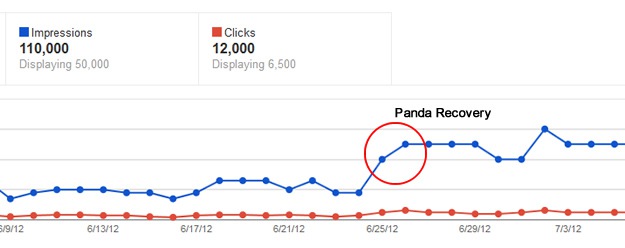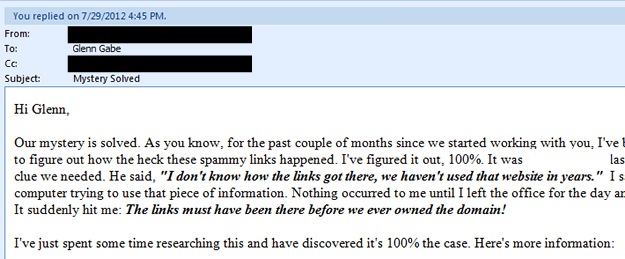 April of 2012 was a rough month for SEO. We had three updates all within nine days: Panda on the 19th, Penguin 1.0 on the 24th, and then a Panda refresh on the 27th.
April of 2012 was a rough month for SEO. We had three updates all within nine days: Panda on the 19th, Penguin 1.0 on the 24th, and then a Panda refresh on the 27th.
It was like an algo sandwich, with a side of panic. Prior to that time, I had already been helping several clients with websites hit by Panda, but the Penguin update was new (and extremely intriguing). And as many webmasters found out, Penguin could be absolutely catastrophic SEO-wise.
After the 24th, I became fascinated with the Penguin update and worked tirelessly to understand what was going on. I’ve now analyzed many domains hit by Penguin (115+); you can read more about my initial Penguin Findings and then my update from the over optimization frontlines. Both provide insights based on my analysis of sites hit by Penguin. It wasn’t long after the 24th that I started helping companies that were hit by Penguin.
An Interesting Case: Panda, Panda, and Pandeguin
One of the emails I received came from a start-up in San Francisco that was clearly in trouble SEO-wise. They had three domains in use, and all three were hit during that nine-day period. To make matters worse, all three were hit by Panda, and one was hit by both Panda and Penguin (or what I call Pandeguin).
Since it’s important to understand which algorithm update hit your site, I analyzed both Google Webmaster Tools and Google Analytics data to confirm which algorithm update hit which domain. My analysis confirmed the Panda, Panda, and Pandeguin situation. Needless to say, we had a lot of work to do.
The Third Domain Was Hit By Both Panda and Penguin

The Power of a Determined CEO
From the very first email and conference call, my client (the founder and CEO of the start-up), was adamant that they never, ever, used spammy link tactics. They never paid for a link, never participated in a link network, never used any sort of link scheme, etc. Sure, we’ve all heard that before, but his tone was serious, and he swore up and down that they never cheated. Although I could clearly see problems with their link profile, I believed him, and wanted to help them recover.
It’s important to highlight the CEO’s determination and resolve. It’s a core reason I wanted to help them, and it would end up paying huge dividends for them down the line. He told me, “We are going to be the best client you’ve ever had. We will take action, and move quickly based on your recommendations. We are determined to fix this situation for the long term.” Again, I believed him. And so the work began.
First Step: Address Panda
I won’t explain all of the details for each of the three domains in this post, since that’s not the point. In a nutshell, all three domains were hit by Panda and were very similar in structure. They had the same layout, navigation, types of content, etc., but they simply targeted three different markets.
After analyzing each site, I could see some glaring issues related to Panda that were the same across the domains, and we moved quickly to address them. We worked hard on analyzing each of the sites, addressing engagement issues, addressing affiliate problems, refining the navigation, etc. The same changes were made to all three domains.
2 out of 3 Ain’t Bad
The Panda refinements were completed relatively quickly, but the third domain needed additional work since it was hit by both Panda and Penguin. On June 25, two of the three domains recovered from Panda. It was awesome to see organic search traffic bounce back, especially when I’ve seen some sites take much longer to return. You can read my post about six months with Panda to learn more about that. We were all excited, but there was still one domain to deal with. Remember, it’s the one hit by Pandeguin.
Two Sites Recovered from Panda on June 25

The third domain not recovering was totally expected by me, since we hadn’t handled the most serious link problems with the domain yet. After an inbound link analysis, I found some classic problematic links (from link networks, spammy pages, etc.)—you know, the ones that Penguins love to feed on. If you don’t know what I am referring to, then think about a website with hundreds of pages of thin content, that includes many exact match anchor text links, all to different sites, across different industries, and within content that didn’t relate to the link.
Remember the CEO who swore up and down that they didn’t break any rules? Well, we had some pretty interesting Web conferences where I shared my screen. The conversation went something like this:
Me: I found this link on {domain A}. The site is filled with spammy links and is part of a larger link network. Here is a link to your site, using exact match anchor text. Do you know how the link got there?
CEO: Glenn, I have never seen this site, this link, or the larger link network. I have no idea how that got there and who set it up. I know this doesn’t look good, but I’m telling you the truth.
The good news is that we identified the Penguin problem. The bad news is that we had to remove those links, and some of the sites would be hard to deal with. I could just tell.
Down The Penguin—I Mean Rabbit—Hole
The CEO wanted to handle the link takedown notices via his email account, which I always think is a smart way to go. So, I would hunt down the links, the domain owners, any other contact information, etc. and the CEO went to work contacting them. He was relentless, which was awesome. It was amazing to see the responses come in; some took down the links at first request, while others gave us the runaround. But what was even more fascinating were the clues that came in one by one regarding who set up the links and how they were set up. We all felt like a special CSI unit, less the dead bodies.
I’ll never forget the email that rolled in on a Saturday evening from the CEO. The subject line was “Mystery Solved” and it seemed that our detective work paid off. One of the website owners we contacted spilled the beans about who set up the paid links. He also noted the date the link was set up. And the date was the key data point we needed.
Why was the date so important? Because my client didn’t own the domain name at that time! The spammy links were all set up prior to my client owning the domain name. That made complete sense given how convincing the CEO was that they never participated in spammy link tactics.
Note: I never asked if the start-up owned the domain from the start. I just assumed they did, based on my previous conversations with them. That was a mistake, and I should have done that earlier on. That said, our process ended up working well, since we found out anyway.

Using this new data, we started to check The Wayback Machine to see when the other spammy links were set up. And you guessed it … they were set up prior to my client owning the domain name. Excellent! This will surely go in the reconsideration request (more on that soon).
So, to quickly recap:
- My client contacted the website owners about removing bad links.
- Many spammy links were removed.
- Several clues were stored away in our CSI lab.
- We were ready to rock and roll with the next Penguin update.
Now That’s a Reconsideration Request!
If you have been hit algorithmically, and not by a manual action, then a reconsideration request won’t help you. Sure, I know that, but I’m a firm believer that you should tell Google everything you did to clean up a serious SEO situation, and that’s especially true when you go through the process we did. It was long, frustrating, and grueling. So I helped the CEO craft a thorough reconsideration request that contained the entire story, all the details, screenshots, who is data, my baby pictures, etc. 🙂
No fewer than five times did the CEO ask me, “Glenn, are you sure this is the right way to structure a reconsideration request?” It seemed long, with many details, and he was fearful that this wasn’t the way to go, but that’s exactly what I wanted Google to see. All the hard work that went into fixing the problem.
Yes, we were adding a lot of data, but I wanted Google to have every bit of evidence to show that my client worked his tail off in order to rectify the Penguin situation. For example, they spent countless hours hunting down links, nuking the links they could, and finding the people who layered a Penguin peck on top of a Panda stomp.
The reconsideration request was submitted on August 8th, and we heard back from Google in a few days. “No manual action has been taken on your site.” I fully expected this and explained that to my client prior to the submission. I also explained that we should brush that off and feel good that Google had what it needed. Now, we just needed another Penguin update so we could be in the clear. Recovery was close—I could feel it.
Penguins Get By with a Little Help from Their *Panda* Friends?
And now the core point of the story. I’m sorry it’s taken so long to get here, but I had to give you a solid rundown of the situation first. The first two domains were doing well at this point. Both recovered from Panda, and we were planning our next steps, but the site that was hit by Pandeguin was still in bad shape. During the three Panda updates since April 27th, nothing had changed … nothing at all. But again, we needed a Penguin refresh, right? Well, that’s what I thought until Panda 3.9.1.
The latest Panda update arrived on August 20, and I admit, I really wanted to hear from a different black-and-white animal. I wanted a Penguin refresh, like many other SEOs who are helping Penguin victims, but something strange happened. The third domain finally spiked. I didn’t rush to conclusions and waited to see how the next few days went.
After a few days of sustained rankings and traffic, it was clear that the site had recovered. So then I waited for official confirmation that a Penguin refresh occurred. I never heard that update from Google. I stalked Barry Schwartz, pinged several other SEO’s I knew, and the answers were all negative. There was not an official Penguin update—at least we thought.
The Third Domain Hit By Panda and Penguin Recovers

If you know me at all or have read my column over the years, you know I’m an inquisitive guy. Needless to say, I had some serious questions. What was going on? Why did a site hit by Penguin recover during a Panda update? Sure, the site was originally hit by Panda and Penguin, but are they related at all? If a site is hit by both, does Panda bubble up to Penguin and make sure Penguin-related issues are resolved? I don’t have the answers, but I would sure love to know.
Again, we made the same changes to all three domains soon after the Panda update on April 27th. All three domains had the same structure, navigation, affiliate setup, types of pages, etc. Two came back at the same time, while the third didn’t budge (the one hit by Penguin). There were no major differences between the three domains with regard to Panda. The only difference was the Penguin situation with the third domain.
Dealing With Algorithm Updates = Tough Stuff
Dealing with major algorithm updates that crush sites is tough stuff. Again, read my post about a company that got hammered by Panda, that did all the right things, but still had to wait six months to recover. The fact of the matter is that there’s not a 10-step process to recovery. You need a deep analysis, the right SEO minds working on the case, and then a swift and precise execution. Then you need to wait and hope the domains recover. It’s not fun. So, I think it’s important to understand what happened with the third site I mentioned above.
Don’t get me wrong, we are beyond excited that all three domains are back. We just want to know more about Pandeguin, and how the third site recovered from Penguin during a Panda update—OK, that last line made me sound insane … only Google can do that to you. 🙂
Here are the core questions I had after the recovery. Again, I don’t have the answers, but my hope is that this case study could help your own recovery efforts by understanding what is possible outside of an official Penguin refresh/update:
- Was there a Penguin refresh during the last Panda update?
- Are Panda and Penguin related? Did the bad link situation have to be resolved before the site could recover from Panda? i.e. Does Panda bubble up to Penguin?
- Did the reconsideration request expedite Penguin recovery? This is just speculation, but was the site cleared and added to a recovery queue (and then released during the next Panda update)? Remember the recent news about Google tricking SEO’s via rank transition? Hey, it’s possible … also, the reconsideration request was submitted only 12 days before Panda 3.9.1.
- Was this just another algorithm update by Google (one of hundreds) that impacted the domain based on all the work that had been done? Read more about the Bigfoot Update by Pete Meyers. The key point is that we shouldn’t focus on just the cute black-and-white animals that Google tells us about. 🙂
The Net-Net
I wish I had more answers for you, but I don’t. The one thing I can tell you is that all three domains are now back. They all recovered from Panda and Penguin, and my client now has a solid SEO platform to build upon, which is exactly what they needed to grow their business.
Beyond the questions I listed above, there are some important lessons from this example. My client didn’t put band aids on the situation. They wanted a long-term plan and stated that from the beginning. They refined all three sites on several levels, and they moved fast. They cleaned up their link profile, which will help them defend against future Penguin updates.
Now that my client has a strong platform for SEO, we can put away the CSI badges, the Penguin traps, and bamboo shoots. That said, those items won’t be kept too far away. It’s important for everyone involved to remember the past few months of algo combat and recovery—it will surely help guide future strategies.
Image Credit: Shutterstock / Neil Bradfield




